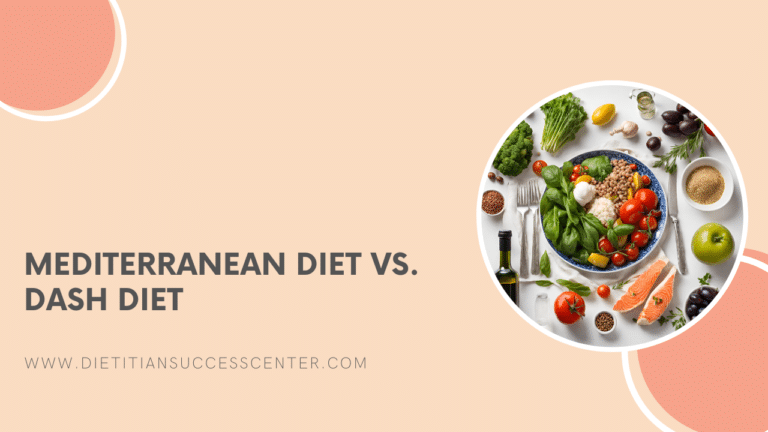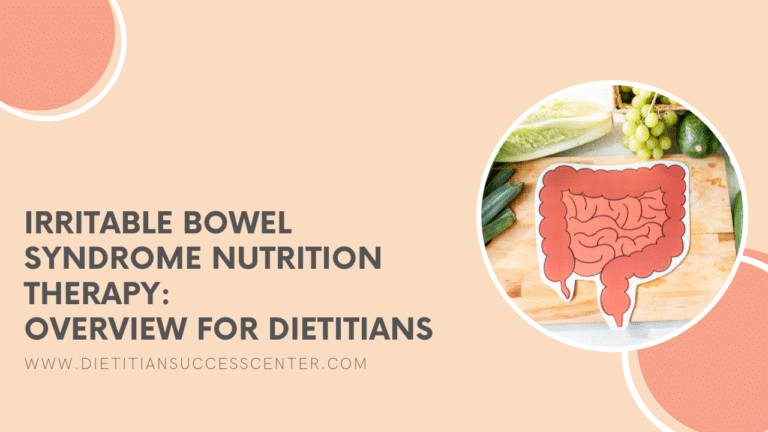

Written by Olivia Farrow, RD, MHSc
Reviewed by Krista Kolodziejzyk, RD, MPH, MBA
In this article, we will delve into the world of CGM for non diabetics, the reasons behind its use and explore its implications for health.
Advancements in technology have made continuous blood glucose monitoring (CGM) systems available to support individuals with diabetes in monitoring and managing their blood glucose. Recently there has been a popularization of these systems for individuals without diabetes.
What is Continuous Glucose Monitoring (CGM)?
Continuous blood glucose monitoring involves wearing a small, discreet sensor that measures glucose levels in the interstitial fluid just beneath the skin for several days (typically 7-14) (1). The sensor is connected to a monitoring device, such as a CGM reader or a smartphone app, which displays real-time continuous glucose data (1).
Continuous glucose monitors were previously only used by individuals with type 1 diabetes (T1DM), and may be beneficial in those with type 2 diabetes or pre-diabetes, for the purpose of glucose control and lowering A1C (2).
CGM can give insight into glucose levels including highs and lows, insulin sensitivity, trends overtime, and how different factors such as food, exercise, sleep, and stress impact levels (3,4,5).
Because the monitor is measuring glucose levels in the interstitial fluid (the fluid between cells), there may be a delay in levels compared to finger prick testing. Individuals with T1DM are typically advised to continue finger prick testing twice daily while using CGM (1,6).
Glycemic Variability Without Diabetes
Glucose variability refers to the extent of fluctuations or changes in blood glucose levels over a period of time (3). It is a measure of how much blood glucose levels rise and fall throughout the day, and can be an indicator of glucose tolerance (3).
In individuals with diabetes, glucose variability can give insight into the effectiveness of diabetes management strategies including medication, nutrition and physical activity (3). In the case of hyper- and hypo- glycemia, there can be serious immediate consequences, especially in those who require insulin injections (3). Long-term complications associated with glucose variability include an increased risk of developing complications related to diabetes, such as cardiovascular disease, neuropathy, retinopathy, and kidney disease (3).
In people without diabetes, blood glucose levels typically remain within a narrow range, with minor fluctuations throughout the day thanks to the body’s regulatory mechanisms (7). After consuming a meal, blood sugar levels will naturally rise, but insulin is released from the pancreas to facilitate the uptake of glucose by cells, helping to bring blood sugar levels back down to normal. The body’s ability to regulate blood sugar is highly efficient, and glucose levels typically return to the normal range within a few hours after eating.
Glucose fluctuations elevated above the normal range (>140 mg/dL) in individuals without diabetes may be a potential risk factor for developing diabetes, cardiovascular disease and overall inflammation (3,8,9).
However, fluctuations in blood glucose levels for non diabetics, particularly postprandial (after eating) remains unclear. This is due to the lack of established standard values for defining what is considered “abnormal” with regards to fluctuations in individuals without diabetes using CGM. A 2019 study examining CGM data in healthy individuals without diabetes, found that the majority of participants consistently maintained blood glucose levels within a normoglycemic range (70-140 mg/dL) (7).
Individuals without diabetes using CGM may become alarmed by elevated glucose levels, despite these levels being within a normal range and subsequently regulated by the body’s inherent systems.
Why is CGM for Non Diabetics so Popular?
Continuous glucose monitors are becoming increasingly popular among people without diabetes. Some companies are offering CGM to nondiabetics alongside dietitian support as a proposed tool to improve health.
One area where CGM has taken off in popularity is among “biohackers”. Biohacking is based on the notion of self-optimization and human enhancement. Proponents use various tools and technologies, including CGM, to understand their unique individual biological needs to optimize and personalize their habits and diet.
The most common reasons for CGM without diabetes include (4):
-
- Understanding and detecting glucose variability to prevent diabetes
-
- Lifestyle optimization and motivating health behavior change
-
- Personalized carbohydrate planning in sports and athletics
Let’s break down each of these common reasons and the evidence behind them.
Understanding and Detecting Glucose Variability
Abnormalities in blood glucose stability, or dysglycemia, is detected in the diagnosis of diabetes through testing of hemoglobin A1C and/or fasting plasma glucose (10).
Learn more about diabetes diagnosis in DSC’s Diabetes Video Course.
Some research suggests that CGM may be a better indicator of pre-diabetes (early dysglycemia), than the traditional tests (10,11). As CGM detects blood glucose levels all day long, it can give insight into glucose stability and insulin sensitivity and thus may encourage individuals and their health care providers to take early preventative strategies for glucose management (5,11). However, more high quality research is needed here to change standards of practice.
Lifestyle Optimization & Motivating Health Behavior Change
Understanding the impact of specific lifestyle factors on blood glucose levels in real time can be a powerful tool for motivating individuals to make health behavior changes and witness immediable “results” (4). While there is currently a lack of high-quality research on sustained behavior change with CGM in individuals without diabetes (4), a small survey-style study on people with diabetes revealed that CGM improved their self-reported motivation for adopting healthier habits (12).
Wearable technology, including fitness trackers, has gained popularity as a means to inspire positive health behavior changes (5). CGM, as a wearable tracker, has shown promising acceptability among users in smaller research studies (13,14).
Continuous glucose monitors can help individuals understand their body’s unique patterns in glucose variability after eating certain foods, combinations of foods, and physical activity (4,5,14). This could also theoretically lead to precision with regard to individualized nutrition recommendations (15).
A rise in postprandial blood glucose (blood sugar spikes after eating) and subsequent insulin response often also leads to subsequent drops in blood glucose or “crashes” and an increased appetite (5,8,16,17). For those experiencing the effects of postprandial rising and falling (“spikes and crashes”) of blood glucose, CGM may aid in an understanding of their individual dietary and lifestyle factors that impact these reactions (15).
CGM may also be able to help motivate individuals to increase their physical activity by being able to see the effects on their blood glucose levels with immediate feedback (14).
Personalized Carbohydrate Planning for Athletes
From nutrition and training regimens to recovery techniques, athletes are constantly seeking ways to optimize their performance (5). CGM has gained interest as a strategy to determine optimal glucose levels and carbohydrate intake in sports (4).
Maintaining a steady supply of glucose for exercise can optimize performance (5). By monitoring glucose levels athletes can fine-tune their carbohydrate intake before, during, and after exercise to ensure optimal glycogen stores, availability of glucose replenishment, and sufficient glucose concentrations in recovery (5,18). CGM can be a useful tool in determining what the individual ideal carbohydrate intake level is for each athlete (18).
A 2022 review in the International Journal of Sport Nutrition and Exercise Metabolism concluded that currently, there is insufficient high quality evidence available on the use of CGM in sports nutrition to draw any major conclusions despite companies selling CGM to athletes andmaking claims about the performance enhancing properties (19). Sports nutrition professionals are integral in the support of diet and carbohydrate optimization for athletes and may find CGM useful for designing individualized recommendations (19).
Learn more about sports nutrition in DSC’s Sports Nutrition Video Course & Resources
Risks and Limitations of CGM for Non Diabetics
There are some risks and limitations of CGM for individuals without diabetes:
Interpretation and Guidance with CGM: There are currently no established standards for assessing CGM values in non diabetic users and a lack of consensus as to how users and health professionals should respond to CGM readings (4,7).
Individuals without the ongoing support of a nutrition professional may not fully understand the meaning of readings. This may lead to fear or misunderstanding related to normal fluctuations of glucose levels throughout the day. There is the potential for the development of food fears, inadequate intake, and disordered eating behaviors related to fear of normal high and low glucose readings (19).
Affordability and Accessibility
CGM systems can be costly and may not be accessible even for individuals with T1DM. Thus, the use of these systems for individuals without diabetes has sparked some controversy. Most CGM devices are available by prescription only and may not be accessible, or covered by insurance, for some.
Key Takeaways
-
- Continuous blood glucose monitoring (CGM) is gaining popularity among individuals without diabetes due to its potential benefits in:
-
- Detection and prevention strategies for pre-diabetes
-
- Motivating behavioral change
-
- Personalizing nutrition and exercise plans
-
- Optimizing athletic performance
-
- Continuous blood glucose monitoring (CGM) is gaining popularity among individuals without diabetes due to its potential benefits in:
-
- There is a need for further research and evidence to establish clear guidelines for non-diabetic users and address limitations in interpretations of blood glucose values. Dietitians supporting those using CGM without diabetes, should be aware that there are no currently established values for interpreting CGM readings within normal range (70-140 mg/dL).
-
- Individuals without diabetes may misinterpret and over-emphasize high or low values which may lead to less healthful lifestyle choice, disordered eating behaviors, or the complete avoidance of some foods. A healthful relationship with food should be encouraged alongside CGM.
References
- National Institute of Diabetes and Digestive and Kidney Diseases (NIDDK). “Continuous Glucose Monitoring” (2017). U.S. Department of Health and Human Services. Available from: https://www.niddk.nih.gov/health-information/diabetes/overview/managing-diabetes/continuous-glucose-monitoring
- Raymond, J., Morrow, K. 2021. “Medical Nutrition Therapy for Diabetes Mellitus and Hypoglycemia”. In Krause and Mahan’s Food & The Nutrition Care Process: 15th Edition. Page 625. Elsevier, Inc.
- Suh S, Kim JH. Glycemic Variability: How Do We Measure It and Why Is It Important? Diabetes Metab J. 2015 Aug;39(4):273-82. doi: 10.4093/dmj.2015.39.4.273. PMID: 26301188; PMCID: PMC4543190.
- Klonoff DC, Nguyen KT, Xu NY, Gutierrez A, Espinoza JC, Vidmar AP. Use of Continuous Glucose Monitors by People Without Diabetes: An Idea Whose Time Has Come? J Diabetes Sci Technol. 2022 Jul 20:19322968221110830. doi: 10.1177/19322968221110830. Epub ahead of print. PMID: 35856435.
- Holzer R, Bloch W, Brinkmann C. Continuous Glucose Monitoring in Healthy Adults-Possible Applications in Health Care, Wellness, and Sports. Sensors (Basel). 2022 Mar 5;22(5):2030. doi: 10.3390/s22052030. PMID: 35271177; PMCID: PMC8915088.
- Cengiz E, Tamborlane WV. A tale of two compartments: interstitial versus blood glucose monitoring. Diabetes Technol Ther. 2009 Jun;11 Suppl 1(Suppl 1):S11-6. doi: 10.1089/dia.2009.0002. PMID: 19469670; PMCID: PMC2903977.
- Shah VN, DuBose SN, Li Z, Beck RW, Peters AL, Weinstock RS, Kruger D, Tansey M, Sparling D, Woerner S, Vendrame F, Bergenstal R, Tamborlane WV, Watson SE, Sherr J. Continuous Glucose Monitoring Profiles in Healthy Nondiabetic Participants: A Multicenter Prospective Study. J Clin Endocrinol Metab. 2019 Oct 1;104(10):4356-4364. doi: 10.1210/jc.2018-02763. Erratum in: J Clin Endocrinol Metab. 2022 Mar 24;107(4):e1775-e1776. PMID: 31127824; PMCID: PMC7296129.
- O’Keefe JH, Gheewala NM, O’Keefe JO. Dietary strategies for improving post-prandial glucose, lipids, inflammation, and cardiovascular health. J Am Coll Cardiol. 2008 Jan 22;51(3):249-55. doi: 10.1016/j.jacc.2007.10.016. PMID: 18206731.
- Levitan EB, Song Y, Ford ES, Liu S. Is nondiabetic hyperglycemia a risk factor for cardiovascular disease? A meta-analysis of prospective studies. Arch Intern Med. 2004 Oct 25;164(19):2147-55. doi: 10.1001/archinte.164.19.2147. PMID: 15505129.
- Rodriguez-Segade S, Rodriguez J, Camiña F, Fernández-Arean M, García-Ciudad V, Pazos-Couselo M, García-López JM, Alonso-Sampedro M, González-Quintela A, Gude F. Continuous glucose monitoring is more sensitive than HbA1c and fasting glucose in detecting dysglycaemia in a Spanish population without diabetes. Diabetes Res Clin Pract. 2018 Aug;142:100-109. doi: 10.1016/j.diabres.2018.05.026. Epub 2018 May 26. PMID: 29807103.
- Hall H, Perelman D, Breschi A, Limcaoco P, Kellogg R, McLaughlin T, Snyder M. Glucotypes reveal new patterns of glucose dysregulation. PLoS Biol. 2018 Jul 24;16(7):e2005143. doi: 10.1371/journal.pbio.2005143. PMID: 30040822; PMCID: PMC6057684.
- Ehrhardt N, Al Zaghal E. Continuous Glucose Monitoring As a Behavior Modification Tool. Clin Diabetes. 2020 Apr;38(2):126-131. doi: 10.2337/cd19-0037. PMID: 32327884; PMCID: PMC7164990.
- Liao Y, Schembre S. Acceptability of Continuous Glucose Monitoring in Free-Living Healthy Individuals: Implications for the Use of Wearable Biosensors in Diet and Physical Activity Research. JMIR Mhealth Uhealth. 2018 Oct 24;6(10):e11181. doi: 10.2196/11181. PMID: 30355561; PMCID: PMC6231900.
- Liao Y, Basen-Engquist KM, Urbauer DL, Bevers TB, Hawk E, Schembre SM. Using Continuous Glucose Monitoring to Motivate Physical Activity in Overweight and Obese Adults: A Pilot Study. Cancer Epidemiol Biomarkers Prev. 2020 Apr;29(4):761-768. doi: 10.1158/1055-9965.EPI-19-0906. Epub 2020 Feb 17. PMID: 32066620; PMCID: PMC7958438.
- Freckmann G, Hagenlocher S, Baumstark A, Jendrike N, Gillen RC, Rössner K, Haug C. Continuous glucose profiles in healthy subjects under everyday life conditions and after different meals. J Diabetes Sci Technol. 2007 Sep;1(5):695-703. doi: 10.1177/193229680700100513. PMID: 19885137; PMCID: PMC2769652.
- Wyatt P, Berry SE, Finlayson G, O’Driscoll R, Hadjigeorgiou G, Drew DA, Khatib HA, Nguyen LH, Linenberg I, Chan AT, Spector TD, Franks PW, Wolf J, Blundell J, Valdes AM. Postprandial glycaemic dips predict appetite and energy intake in healthy individuals. Nat Metab. 2021 Apr;3(4):523-529. doi: 10.1038/s42255-021-00383-x. Epub 2021 Apr 12. Erratum in: Nat Metab. 2021 Jul;3(7):1032. PMID: 33846643; PMCID: PMC7610681.
- Chandler-Laney PC, Morrison SA, Goree LL, Ellis AC, Casazza K, Desmond R, Gower BA. Return of hunger following a relatively high carbohydrate breakfast is associated with earlier recorded glucose peak and nadir. Appetite. 2014 Sep;80:236-41. doi: 10.1016/j.appet.2014.04.031. Epub 2014 May 10. PMID: 24819342; PMCID: PMC4204795
- Ishihara K, Uchiyama N, Kizaki S, Mori E, Nonaka T, Oneda H. Application of Continuous Glucose Monitoring for Assessment of Individual Carbohydrate Requirement during Ultramarathon Race. Nutrients. 2020 Apr 17;12(4):1121. doi: 10.3390/nu12041121. PMID: 32316458; PMCID: PMC7230511.
- Bowler AM, Whitfield J, Marshall L, Coffey VG, Burke LM, Cox GR. The Use of Continuous Glucose Monitors in Sport: Possible Applications and Considerations. Int J Sport Nutr Exerc Metab. 2022 Dec 26;33(2):121-132. doi: 10.1123/ijsnem.2022-0139. PMID: 36572039.








